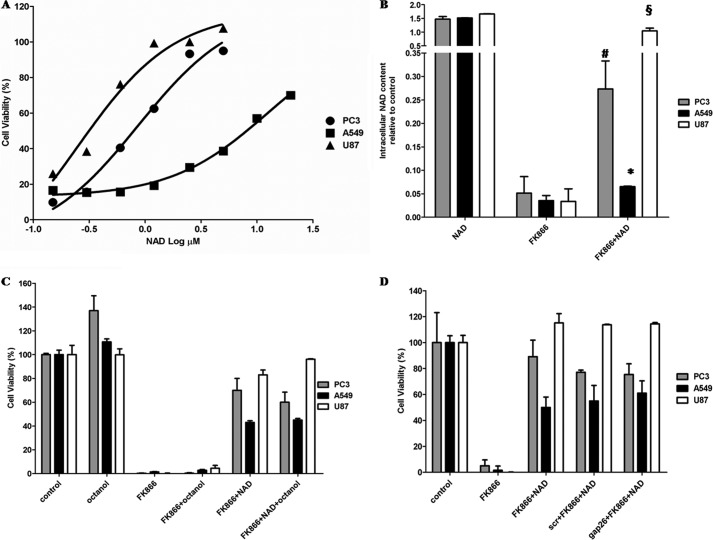FIGURE 1.
Extracellular micromolar NAD+ improves cell viability and increases intracellular NAD+ content in FK866-treated cells. A, A549, PC3, and U87 cell viability was evaluated by a sulforhodamine B colorimetric assay (SBC) after a 72-h incubation of cells in complete medium in the presence (or not) of 30 nm FK866, with the addition (twice a day) of 0, 0.15, 0.30, 0.6, 1.2, 2.5, 5, 10, or 20 μm NAD+. Results are expressed as a percentage of cell growth relative to untreated cells. In the absence of NAD+, FK866 treatment resulted in 8.6 ± 0.4, 11.9 ± 0.4, and 11.4 ± 1.4% cell viability in PC3, A549, and U87 cells, respectively. EC50 values for the NAD+-rescuing activity were calculated from the non-linear regression curves with GraphPad Prism version 5. R2 values were 0.981 for PC3, 0.993 for A549, and 0.966 for U87 cells. B, A549, PC3, and U87 cells were treated for 72 h with or without 30 nm FK866 in the presence or absence of 10 μm NAD+ (added twice a day). Cells were harvested and lysed in 0.6 m PCA, and NAD+ content was measured in neutralized extracts. NAD+ values, normalized to protein content, are expressed as relative to untreated, control cells. Data are expressed as mean ± S.D. (error bars) (n = 3). The intracellular NAD+ content was 6.2 ± 1.1, 7.1 ± 0.9, and 11.6 ± 1.9 nmol/mg protein in A549, PC3, and U87 cells, respectively. *, p < 0.05; #, p < 0.01; §, p < 0.001 compared with the corresponding FK866-treated cells. C, A549, PC3, and U87 cell viability was evaluated by SBC after a 72-h incubation of the cells in complete medium without (control) or with 30 nm FK866 or with FK866 supplemented with either 1 mm octanol or 10 μm NAD+ (added twice a day). Results are expressed as a percentage of cell growth relative to untreated cells. Data are expressed as mean ± S.D. (n = 3). No statistical difference was observed between cells treated with FK866 and NAD+ in the presence or absence of octanol. D, A549, PC3, and U87 cell viability was evaluated by SBC after a 72-h incubation of the cells in complete medium with or without 30 nm FK866, 10 μm Gap26, or a scrambled peptide (scr) and 10 μm NAD+ (added twice a day). Results are expressed as a percentage of cell growth relative to untreated cells. Data are expressed as mean ± S.D. (n = 3). No statistical difference was observed between cells treated with FK866 and NAD+ in the presence or absence of scrambled peptide or Gap26.

